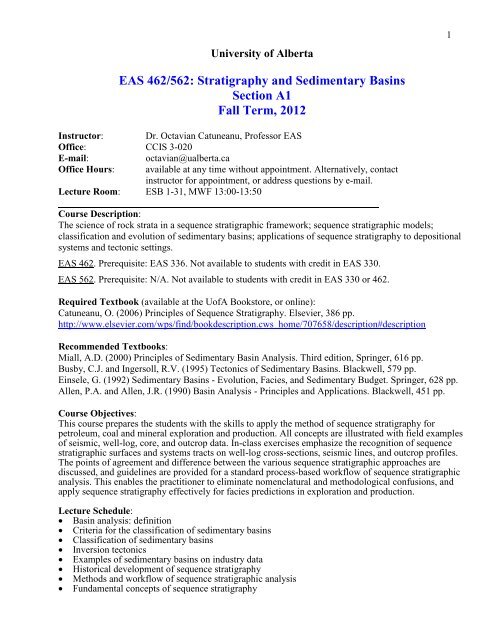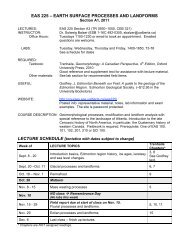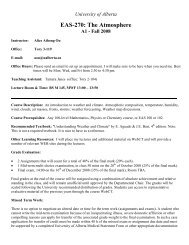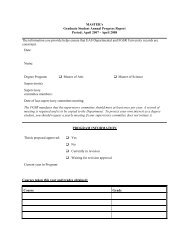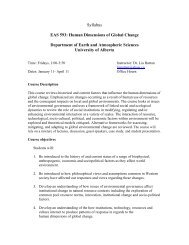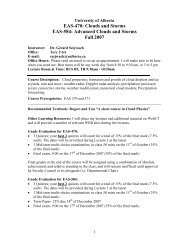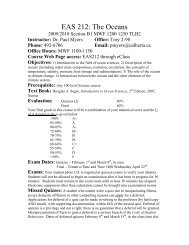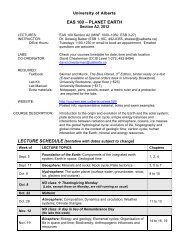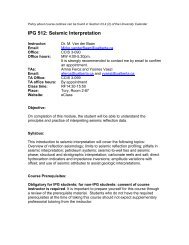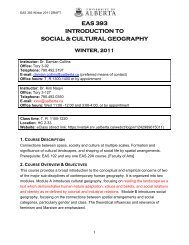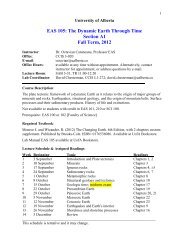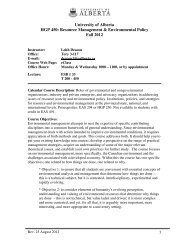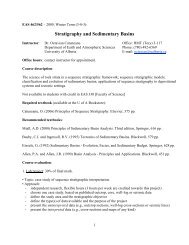Course Title - University of Alberta
Course Title - University of Alberta
Course Title - University of Alberta
- No tags were found...
You also want an ePaper? Increase the reach of your titles
YUMPU automatically turns print PDFs into web optimized ePapers that Google loves.
<strong>University</strong> <strong>of</strong> <strong>Alberta</strong>1EAS 462/562: Stratigraphy and Sedimentary BasinsSection A1Fall Term, 2012Instructor: Dr. Octavian Catuneanu, Pr<strong>of</strong>essor EASOffice: CCIS 3-020E-mail:octavian@ualberta.caOffice Hours: available at any time without appointment. Alternatively, contactinstructor for appointment, or address questions by e-mail.Lecture Room: ESB 1-31, MWF 13:00-13:50<strong>Course</strong> Description:The science <strong>of</strong> rock strata in a sequence stratigraphic framework; sequence stratigraphic models;classification and evolution <strong>of</strong> sedimentary basins; applications <strong>of</strong> sequence stratigraphy to depositionalsystems and tectonic settings.EAS 462. Prerequisite: EAS 336. Not available to students with credit in EAS 330.EAS 562. Prerequisite: N/A. Not available to students with credit in EAS 330 or 462.Required Textbook (available at the U<strong>of</strong>A Bookstore, or online):Catuneanu, O. (2006) Principles <strong>of</strong> Sequence Stratigraphy. Elsevier, 386 pp.http://www.elsevier.com/wps/find/bookdescription.cws_home/707658/description#descriptionRecommended Textbooks:Miall, A.D. (2000) Principles <strong>of</strong> Sedimentary Basin Analysis. Third edition, Springer, 616 pp.Busby, C.J. and Ingersoll, R.V. (1995) Tectonics <strong>of</strong> Sedimentary Basins. Blackwell, 579 pp.Einsele, G. (1992) Sedimentary Basins - Evolution, Facies, and Sedimentary Budget. Springer, 628 pp.Allen, P.A. and Allen, J.R. (1990) Basin Analysis - Principles and Applications. Blackwell, 451 pp.<strong>Course</strong> Objectives:This course prepares the students with the skills to apply the method <strong>of</strong> sequence stratigraphy forpetroleum, coal and mineral exploration and production. All concepts are illustrated with field examples<strong>of</strong> seismic, well-log, core, and outcrop data. In-class exercises emphasize the recognition <strong>of</strong> sequencestratigraphic surfaces and systems tracts on well-log cross-sections, seismic lines, and outcrop pr<strong>of</strong>iles.The points <strong>of</strong> agreement and difference between the various sequence stratigraphic approaches arediscussed, and guidelines are provided for a standard process-based workflow <strong>of</strong> sequence stratigraphicanalysis. This enables the practitioner to eliminate nomenclatural and methodological confusions, andapply sequence stratigraphy effectively for facies predictions in exploration and production.Lecture Schedule: Basin analysis: definition Criteria for the classification <strong>of</strong> sedimentary basins Classification <strong>of</strong> sedimentary basinsInversion tectonicsExamples <strong>of</strong> sedimentary basins on industry data Historical development <strong>of</strong> sequence stratigraphy Methods and workflow <strong>of</strong> sequence stratigraphic analysis Fundamental concepts <strong>of</strong> sequence stratigraphy
Sequence stratigraphic surfacesSystems tractsSequences and sequence modelsTime attributes <strong>of</strong> stratigraphic surfacesHierarchy <strong>of</strong> sequences and sequence boundariesApplications to all depositional systems2Theory sections are followed by in-class exercises presented by the instructor to illustrate the concepts.Grade Evaluation:This course will be graded on the basis <strong>of</strong> three assignments: a Lab Project, a Term Assignment, and aFinal Assignment. All assignments will be given a numerical score. A cumulative course mark will becalculated from those scores, weighted as tabulated below.Marks <strong>of</strong> the Lab Project, the Term Assignment, and the Final Assignment will reflect the absolute level<strong>of</strong> performance <strong>of</strong> each student, as well as the performance relative to other students in the class.Marks will be translated into letter grades following the <strong>University</strong> curve for 400- and 500-level courses.Grading will make use <strong>of</strong> natural breaks in the distribution <strong>of</strong> marks to define grade boundaries, and willresult in a mean final grade for the course that is reasonably close to the historical means <strong>of</strong> the<strong>University</strong> for 400- and 500-level courses.EVALUATION WEIGHTING DEADLINELab Project 30% 21 NovemberTerm Assignment 30% 24 OctoberFinal Assignment 40% 5 DecemberGrades are un<strong>of</strong>ficial until approved by the Department and/or Faculty <strong>of</strong>fering the course.Format <strong>of</strong> Assignments:All assignments involve independent research, with guidance from instructor and TA.Lab Project: 30% <strong>of</strong> final mark (3 hours per week are credited towards this project)• Topic: a case study <strong>of</strong> sequence stratigraphic interpretation• Approach:- choose one case study, based on published outcrop, well-log or seismic data. Common sources <strong>of</strong>data include: research articles in journal or books; AccuMap well-log data base; atlases <strong>of</strong> seismiclines; the Geological Atlas <strong>of</strong> the Western Canada Sedimentary Basin:http://www.ags.gov.ab.ca/publications/ATLAS_WWW/ATLAS.shtml- two or more students cannot select the same case study• Structure: your Lab Project should include 4 sections1. Introduction:- Slide 1: title <strong>of</strong> project; source <strong>of</strong> information (i.e., cite the reference where the data come from);indicate the depositional and tectonic settings;- Slide 2: present the study area (i.e., location map);- Slide 3: present the stratigraphic objective (name and age <strong>of</strong> the unit under analysis, and adjacentunits: i.e., stratigraphic chart).2. Presentation <strong>of</strong> data:- Slide 4: indicate the type <strong>of</strong> data available (e.g., sedimentologic, biostratigraphic, geophysical, etc.),and the evidence for the depositional system(s) in your case study;
- Slide 5: present the uninterpreted data (one cross-section, if you use outcrop or well-log data, or oneseismic line, if you use seismic data). Indicate the location <strong>of</strong> your cross-section or seismic line onthe location map. Choose the horizontal and vertical scales such that the details on your crosssectionor seismic line are visible on a tabloid-size (11 x 17 inches) paper; indicate the depositionalsystem(s) on your cross-section or seismic line.3. Sequence stratigraphic interpretation:- Slide 6: mark sequence stratigraphic surfaces on your cross-section or seismic line. Yourinterpretation may or may not agree with previously published interpretations. You must becomfortable with your interpretation and able to defend it.4. Discussion (Slide 7): discuss the potential pitfalls <strong>of</strong> your interpretation, and the feasibility <strong>of</strong>alternative interpretations.• Submit: one PPT file (include a figure caption in the footnote <strong>of</strong> each slide; every piece <strong>of</strong> informationthat is not your original work must be credited to the original source).• Deadline: 21 November 2012 (two weeks before the last day <strong>of</strong> classes).NB: If time permits, you may be asked to make a 15-minute oral presentation <strong>of</strong> your Lab Projectanytime after the deadline, during the last two weeks <strong>of</strong> classes.Term Assignment: 30% <strong>of</strong> final mark• Topic: presentation <strong>of</strong> a tectonic setting• Approach:- select one tectonic setting from the list below- if two or more students have selected the same tectonic setting, the case studies must be different• Structure: your Term Assignment should include 3 sections1. Introduction:- Slide 1: title; definition <strong>of</strong> the type <strong>of</strong> sedimentary basin that you have selected;- Slide 2: main characteristics <strong>of</strong> that particular tectonic setting: physiography, scale, underlyingcrust, subsidence mechanisms, depositional systems and sources <strong>of</strong> sediment supply.2. Case study: present one case study that illustrates stratigraphic cyclicity in that tectonic setting.- Slide 3: location map (indicate study area);- Slide 4: stratigraphic chart (indicate stratigraphic objective);- Slide 5: one cross-section (if you use outcrop or well-log data) or one seismic line; indicate thedepositional system(s) on your cross-section or seismic line; indicate stratigraphic cyclicity on yourcross-section or seismic line (NB: no sequence stratigraphic interpretation is expected);3. Discussion (Slide 6): discuss the controls on stratigraphic cyclicity in that particular tectonic setting(i.e., the cycle-forming mechanisms); indicate the temporal scale(s) <strong>of</strong> the observed cycles.• Submit: one PPT file (include a figure caption in the footnote <strong>of</strong> each slide; every piece <strong>of</strong> informationthat is not your original work must be credited to the original source).• Deadline: 24 October 2012 (six weeks before the last day <strong>of</strong> classes).NB: the case study selected for the Term Assignment must be different from the case study selected forthe Lab Project.Final Assignment: 40% <strong>of</strong> final mark• Topic: application <strong>of</strong> sequence stratigraphy to a tectonic setting• Approach:- select one tectonic setting from the list below (same as the one selected for the Term Assignment)3


